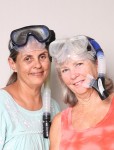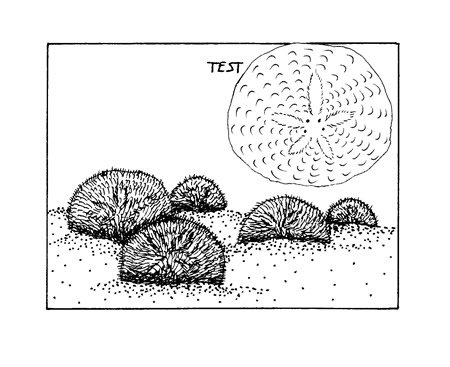
Although we seldom find evidence of them on the beach, many coves of Laguna Beach have a secret treasure residing on the sandy bottom just off shore. Getting its name from the similarity it has in size and shape to the silver dollar, it is the Pacific sand dollar (Dendraster excentricus). Colored in shades of dull purple, they can reach up to three inches in size. Having a geographic range from Alaska to Baja California, they are usually found in less than 30 feet of water, although they have been found at depths up to 300 feet. They are found in patchy distributions, partially buried vertically in the sand, lying in rows that are usually angled toward the same direction. Sometimes they occur in such large and dense aggregations that they appear stacked one on top of the other.
Also called the eccentric sand dollar, it is an echinoderm, a group which includes the sea urchin and sea star. Like the rest of the family, it is distinguished by the plates of their test (bony exoskeleton) having five point radial symmetry around a central axis. Like the sea urchin, the test is surrounded by spines used for burrowing and locomotion. Unlike the sea urchin, the sand dollar’s spines are very short and fine and covered with cilia that give the animal a soft, velvety feel. Five sets of paired tube feet on the underside of its body are used for respiration, feeding and locomotion. Omnivores, they are suspension feeders with the cilia trapping organic particles of plankton, larvae, detritus and diatoms that is carried to Aristotle’s lantern, the beak-like mouth located on the underside of the body. It is interesting to note that juvenile sand dollars have been found to ingest sand grains, which are thought to act as ballast to stabilize them in the sand. Believed to have a nine to 13 year lifespan, after death the tests are rolled by currents until the spines rub off and it is bleached to its more recognizable form.
 The Pacific sand dollar is dioecious, either male or female and reproduces by broadcast spawning. Reaching sexual maturity at one to four years, they spawn once a year and depending on their geographical location, spawning can start in May and last until early autumn. Fertilization is external with the female releasing yellow eggs and the male releasing white sperm into the open ocean. The larvae go through several stages as they free float in the water before finally settling on the sand and developing their exoskeleton. Storms are responsible for the mass mortality of sand dollar colonies. In general their predators include fish such as sheepheads, flounders and perches and the Giant Pink Sea Star. In addition, gulls and crabs have been known to eat them.
The Pacific sand dollar is dioecious, either male or female and reproduces by broadcast spawning. Reaching sexual maturity at one to four years, they spawn once a year and depending on their geographical location, spawning can start in May and last until early autumn. Fertilization is external with the female releasing yellow eggs and the male releasing white sperm into the open ocean. The larvae go through several stages as they free float in the water before finally settling on the sand and developing their exoskeleton. Storms are responsible for the mass mortality of sand dollar colonies. In general their predators include fish such as sheepheads, flounders and perches and the Giant Pink Sea Star. In addition, gulls and crabs have been known to eat them.
Able to respond to environmental conditions and being fairly mobile, the Pacific sand dollar exhibits seasonal migration of their colonies. In winter, the beds are closer to shore in water as shallow as 10 feet and in summer, further out in deeper water. The Pacific sand sollar test is so fragile that it rarely washes up on our sandy beaches intact. However, in the cold, clear winter water of Laguna, it is easily possible to see sand dollar colonies while snorkeling close to shore.
Residents and ocean swimmers Mia Davidson and artist Jan Sattler believe that a better understanding of our local marine resources will advance the protection of this important ecosystem.




